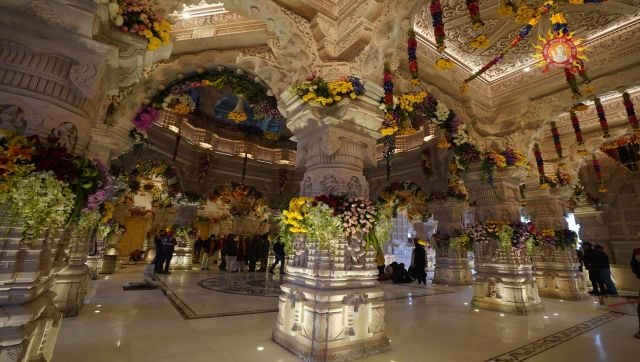Today marks the grand and historic consecration ceremony of the Ram mandir in Ayodhya and the excitement around the event is palpable. While VVIPs from across the country and world will be in attendance for the event today (22 January), the temple will open its doors to devotees starting tomorrow (23 January).
And those who visit the mandir, are in for an architectural wonder. Built by Chandrakant Sompura and his son, it has been designed in the Nagara-style of architecture and is built with no steel or iron.
But what exactly is the Nagara-style of architecture? What is the connection of this style with Hinduism?
Here’s what we know.
Origins of Nagara-style architecture
Before we delve into the origin of this style of architecture, we explain what it means. The word nagara means city. This means that this style is closely associated with urban architecture. According to experts, the Nagara-style of architecture emerged around fifth century CE, during the late Gupta period, in northern India.
While it may have flourished during the Gupta period, it evolved through various regional kingdoms and empires that ruled over the northern parts of India. Experts state that India had two styles of architecture — Nagara and Dravidian. While the former was more prominent in the North, the latter style emerged in the South.
Catch all the LIVE updates from the Ram mandir consecration ceremony HERE
There are also experts who observe that calling it a style is incorrect. In fact, Adam Hardy wrote in his highly influential The Temple Architecture of India, “Nagara and Dravida may be called ‘styles’, but they cover vast areas and time spans.
“Languages’ seems a [more] suitable term, in that each is a system providing a ‘vocabulary’, a kit of parts, along with a ‘grammar’ which regulates the ways of putting the parts together,” he wrote.
Over the years, many temples have been designed in the Nagara-style. For instance, the Sun Temple in Odisha’s Konark, the Kandariya Mahadeva Temple in Khajuraho, and the Jagdish temple in Udaipur.
Significant features of Nagara-style of architecture
This style of construction has some significant features. One of the most prominent features of this style its tower-like structures, known as ‘shikhara’ or spires, which rise vertically, symbolising the sacred mountain, Mount Meru, considered to be the centre of the physical, metaphysical and spiritual dimensions in Hindu, Jain and Buddhist cosmology.
Another significant feature of temples built in the Nagara-style of architecture is that they are built on a raised plinth, with the sanctum sanctorum, the garbha griha, being the most sacred part of the temple. Moreover, the ‘garbha griha’ is always located directly below the highest shikhara.
According to an article published by The Architects Diary titled ‘Nagara Style Temple Architecture: Masterpieces in Stone, the layout of Nagara style temples follows a distinct pattern, reflecting the cosmic order and the journey of the soul towards liberation.
Also read: Stone from Rajasthan, granite from Telangana: How Ram Temple in Ayodhya will have features from across the country
At the core of the temple is the Vastu Purusha Mandala, a sacred diagram representing the cosmic man. The temple’s plan is aligned with this mandala, ensuring that the deity’s sanctum aligns with the cosmic forces.
Next comes the garbha griha, where the deity is placed. Often square, this chamber is a symbol of the womb of creation. The placement of the deity within this sacred space is meticulously calculated to maintain harmony with cosmic energies.
Around the garbha griha is the circumambulatory path called the pradakshina patha. This allows visitors to walk in a clockwise direction around the deity.
All Nagara-style temples will also feature a mandapa, or congregation hall, serves as a communal space for rituals, gatherings, and celebrations. Supported by intricately carved pillars, the mandapa’s design is often open, allowing devotees to participate in ceremonies. The pillars themselves are adorned with sculptures depicting deities, mythological narratives, and celestial beings, contributing to the immersive spiritual experience.
Variations in Nagara-style architecture
Within the Nagara-style of design, there are variations on the basis of what the shikhara looks like. According to Adam Hardy, there are five variations — Valabhi, Phamsana, Latina, Shekhari, and Bhumija.
In the Latina variation, there’s a simple shikhara with square bases and inwardly curved walls with pointed apexes. Meanwhile, the Shekhari shape has attached sub-spires or spirelets, echoing the main shape. The Bhumija, on the other hand, has miniature spires, in horizontal and vertical rows, all the way to the top, creating a grid-like effect on each face.
Different schools of Nagara-style architecture
The temples in Nagara style have also evolved geographically, taking on features of the place where it is built. There is the Orissan Nagara, which is characterised by its towering shikhara and exquisite stone carvings.
Apart from Orissan Nagara, there’s also the Rajasthani Nagara. The main characteristic feature of this school is the fortified walls and ornate entryways. The Gujarati Nagara style is known for its elegance and simplicity. What sets them apart from their northern counterparts is that the shikharas are relatively modest in height.
Additionally, there’s the Karnataka Nagara which have a more subdued and tapering shikhara compared to their northern counterparts. The emphasis is often on detailed carvings on pillars and walls, depicting scenes from mythology.
Last but not the least is the Central Indian Nagara. Temples in this style often feature a variety of spire shapes, including the stepped shikhara.
With inputs from agencies
Link to article –
Ram mandir: What’s Nagara style of architecture of the Ayodhya temple?





